Ele Carpenter and Pieter Fannes. Underground/Overground.
An Annotated Visual Report
Curator Ele Carpenter looks back on the Nuclear Culture Roundtable held on November 17th at Z33, and shares what she took home from the talks and debates, inspired by Pieter Fannes’ drawings.
The seventh Nuclear Culture Roundtable on the Underground / Overground brought together fifty people from across the arts, sciences and humanities to discuss how we conceptualize hiding waste underground in relation to daily life on the earth’s surface. The event took place on 17 November at Z33 alongside the Perpetual Uncertainty exhibition. Working closely with NIRAS/ONDRAF the event focused on art and radioactive waste storage in Belgium, including the problems of: geological storage, the difficulty of communicating or marking contaminated sites for future generations, and the question of designing infrastructures for a deep time future. The morning presentations gave short introductions to different perspectives on radioactive waste management and art, whilst in the afternoon we divided into three groups for in-depth roundtable discussions. Illustrator Pieter Fannes made a poignant visual report of the discussions, capturing some of the passions and ideas of the day.
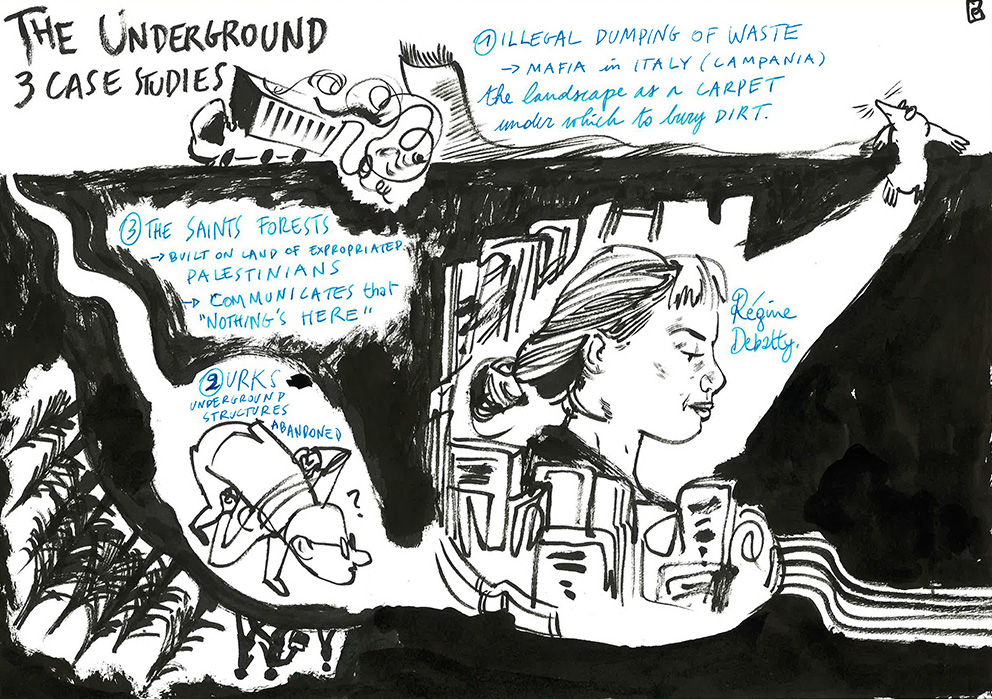
The presentations began with Régine Debatty’s introduction to how we conceptualise the subterranean. For humans, too often burying things underground means ‘out of sight and out of mind’. Regine evoked a complex subterranean world of interwoven infrastructures made from layers of cabling, tunnelling and potentially reusable and valuable materials, invoking Björn Wallsten’s concept of the Urk. An image perfectly captured in the detail of Pieter Fannes drawing above, which sets the scene for thinking about the challenges of storing radioactive waste underground, that we might forget, or that we might need to dig up.
When conceptualising the complexities of radioactive waste it’s very helpful to look both within, and beyond, the nuclear discourse to think about the wider aesthetic, cultural and political implications of the underground. Dominant groups of people are quite capable of being completely blind to the things they don’t want to see, denouncing landscapes as ‘empty’, or transforming them with new historical narratives. For example, Adam Broomberg and Oliver Chanarin’s photo series « Forest » (2005) deals with how several parks in Israel, such as the Ben Sheman forest, were planted with fast growing imported pine trees erasing ancient Palestinian villages and slow-growing olive groves, quickly transforming the region into a European style landscape. This example demonstrates how strategic forces impact on how landscapes are remembered, and how they can be overwritten with new habitats and architectures as a process of erasing memory.
If the concept of the atomic sublime is about the awe inspiring immeasurable visual spectacle of the atomic explosion, viewed from a safe distance. The storage of radioactive waste in deep geologic repositories creates a sense of the invisible uncanny underground; creating a lurking fear that all is not as it should be deep below our feet.
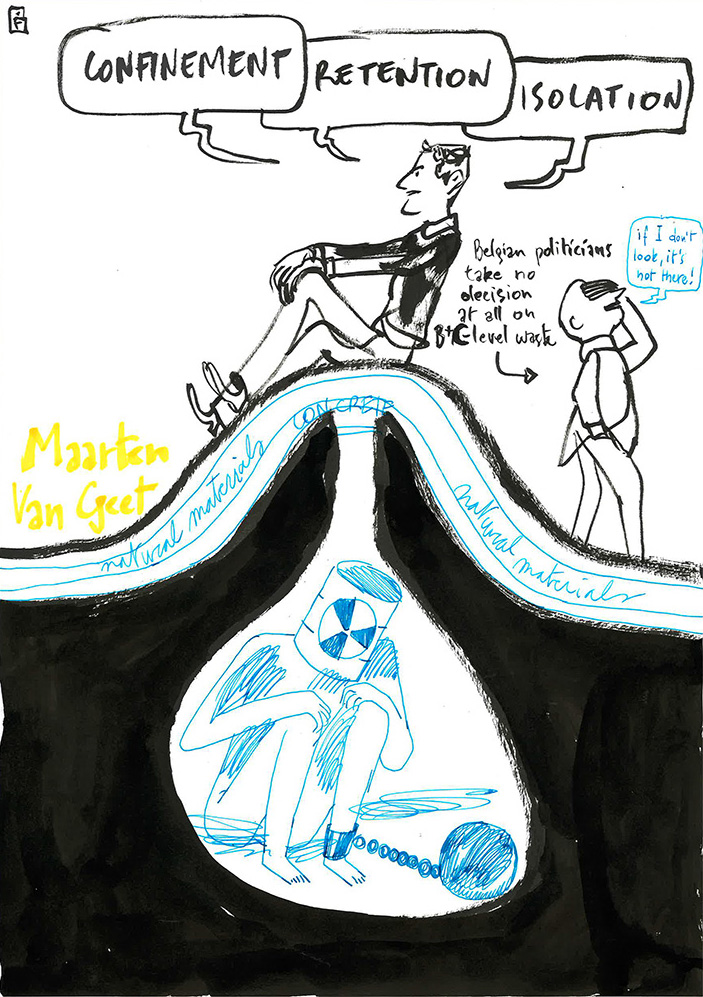
To start thinking about underground storage of radioactive waste in Belgium, Maarten Van Geet from NIRAS/ONDRAF outlined the Belgian Radioactive Waste Agency’s thinking on the safest way to store high-level waste. As depicted in Pieter Fannes drawing, the agency is confident in its research into storing waste in Boom clay. They have an underground research laboratory called HADES where scientists and engineers have been conducting experiments in the clay since the 1980s. But the political decision to go ahead and build a final geological repository has yet to be made.
Pieter Fannes’s drawing powerfully captures the waste as an interned figure, reminding us that radioactive waste is intimately human, created by human nuclear technology. The plan is that the waste will be ‘confined’ in vitrified glass, steel canisters and concrete boxes; whilst a top layer of materials will form a barrier to ‘isolate’ the waste from the biosphere.
Maarten Van Geet explained that construction on the Category A low-level waste storage at Dessel will start in 2018, and will form a 20 meter high hill to contain waste which needs to be isolated for 300 years; whilst the final geologic facility will be designed for up to 1 million years, and its construction has yet to be approved.
Anne Bergmans, Professor of Sociology at Antwerp University, discussed the social challenges of storing radioactive waste as an integral part of the process of siting, storing and monitoring radioactive waste. Anne and her team have been working with community groups around Belgium’s nuclear sites at Dessel and Mol, and are supporting the social and democratic models for local decision making about the sites. Anne presented five challenges to considering what is social underground: Acknowledging the social from NIMBY to volunteerism; Upstream engagement in the production and storage of waste; The necessary problem of the finer details coming later; Organisation of long-term governance; Problem of boredom in such a long-term process.
Fannes’ drawing of Anne emphasises how she supports the values of social equity and justice to enable local communities to be engaged in decision making about nuclear waste.
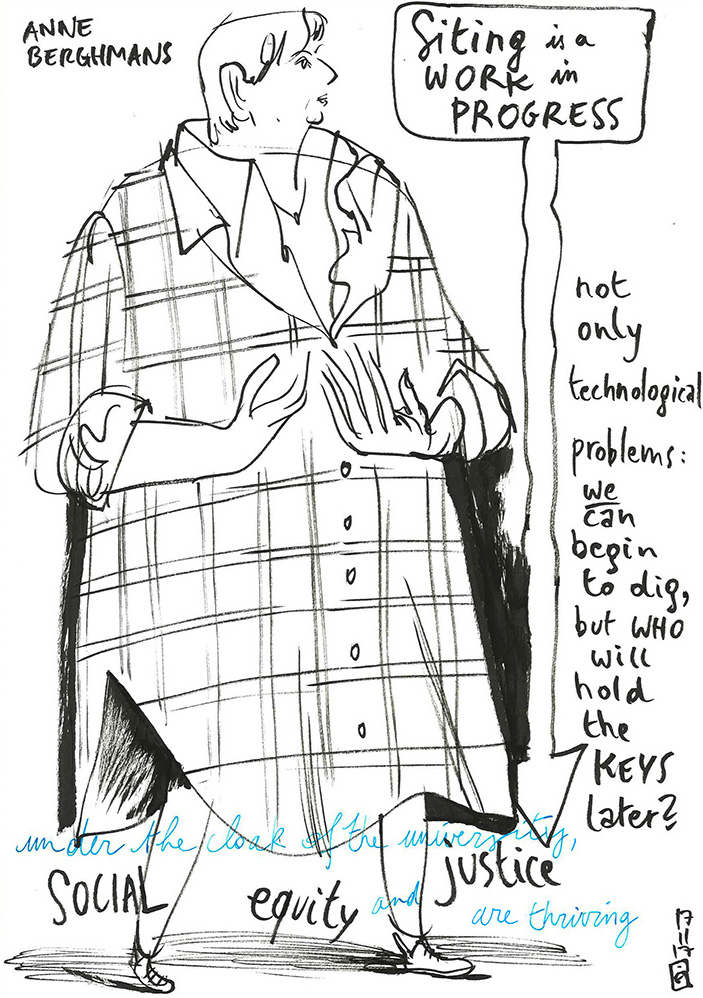
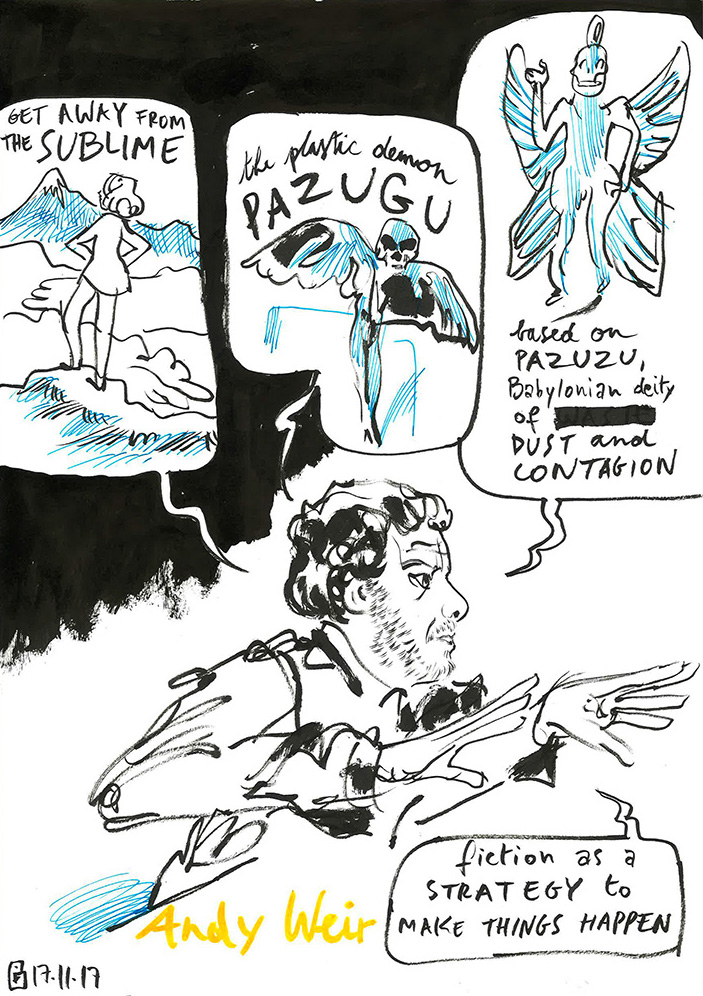
Artist Andy Weir took a more deep time philosophical approach, considering how nuclear waste reconfigures human-centrism, thinking beyond humans, where the waste might displace the human species. Andy’s artistic project is based on Pazugo, a Babylonian deity of dust and contagion, a god of invisible forces reconfigured through group workshops to create mutated figures to be buried at waste sites, exhibited in art galleries and archived in museums. In Andy’s work, fiction is used as a performative device, as a strategy to make things happen. When considering nuclear landscapes, Andy Weir is trying to avoid the romantic sublime and rethinking the deep time of plutonium to consider different models of the future.
When reflecting on Régine Debatty and Andy Weir’s presentations we might consider the notion of the Deep Time Uncanny: where uncertainty about the future creates an uncanny spectre in the present.
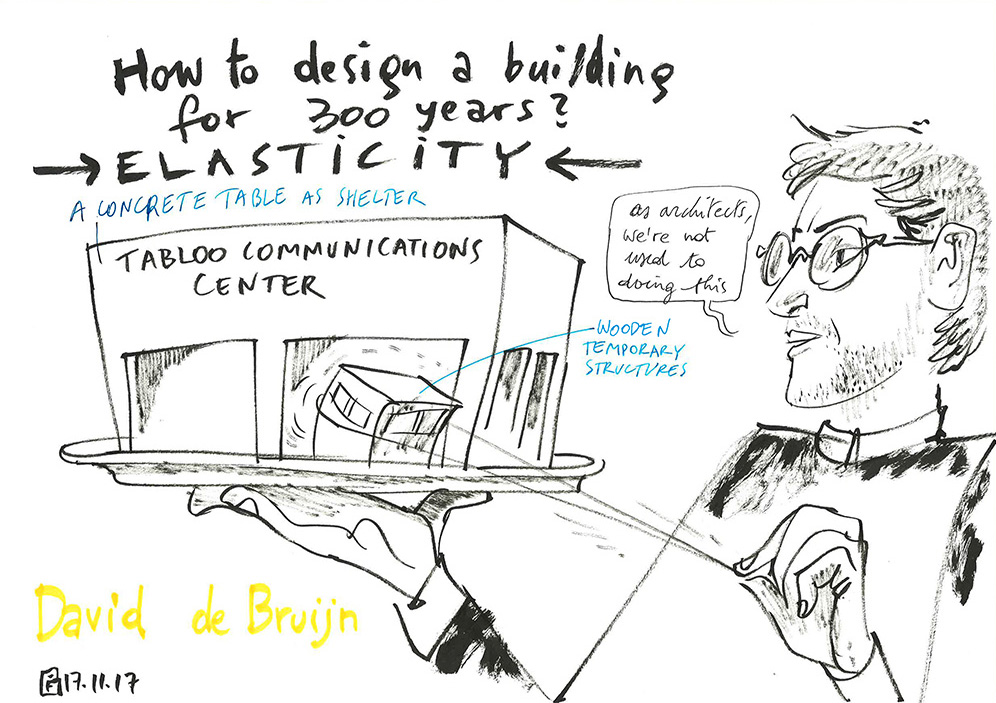
David De Bruijn from ONO Architecture, presented the co-design for the Tabloo Communications Center planned to be built in Dessel in the next few years. The permanent large concrete structure will act as a shelter for a complex of smaller, more flexible wooden buildings underneath. The building is a Co-Design project that involves the architects working closely with the MONA and STORA local community stakeholder groups in the area. The project includes a raised walk-way which enables visitors to walk over the boundaries of the site, and look over the mounds where the low level waste will be buried. As well as providing access to the new landscape, the Tabloo building aims to be a cultural center, housing a permanent exhibition about radiation and radioactive waste storage, as well as a temporary exhibition space and auditorium.
Riet from MONA and Herman from STORA gave a presentation about the role of their community organisations taking a societal approach to waste management, also working with Anne Bergmans at Antwerp University. They are both non-profit organisations co-founded by the neighbouring municipalities of Mol (MONA) and Dessel (STORA), and NIRAS, the Belgian Agency for Radioactive Waste Management and Fissile Material. Both groups involve residents who used to work at the nuclear sites, such as nuclear scientists and concrete engineers. Even Madame Curie worked near Dessel where she prepared the first gram of radium.
MONA and STORA facilitate communication between the community and NIRAS, they have a regular newsletter, carry out public surveys, and provide an open forum for negotiation. STORA is a long-term partner in the Category A low-level waste project and has consulted on a reversible solution which is socially acceptable to the community, taking into account the interests of Mol. STORA made a binding agreement that states the rights and duties of all parties concerned, and will continue to monitor the Category A site in the future. Whilst MONA was established to focus on the development of a high level waste geologic disposal in Mol, the long term research and planning process means that it may take another generation before the project is realised. In the meantime MONA is also involved in the consultation process about the Category A project in neighbouring Dessel.
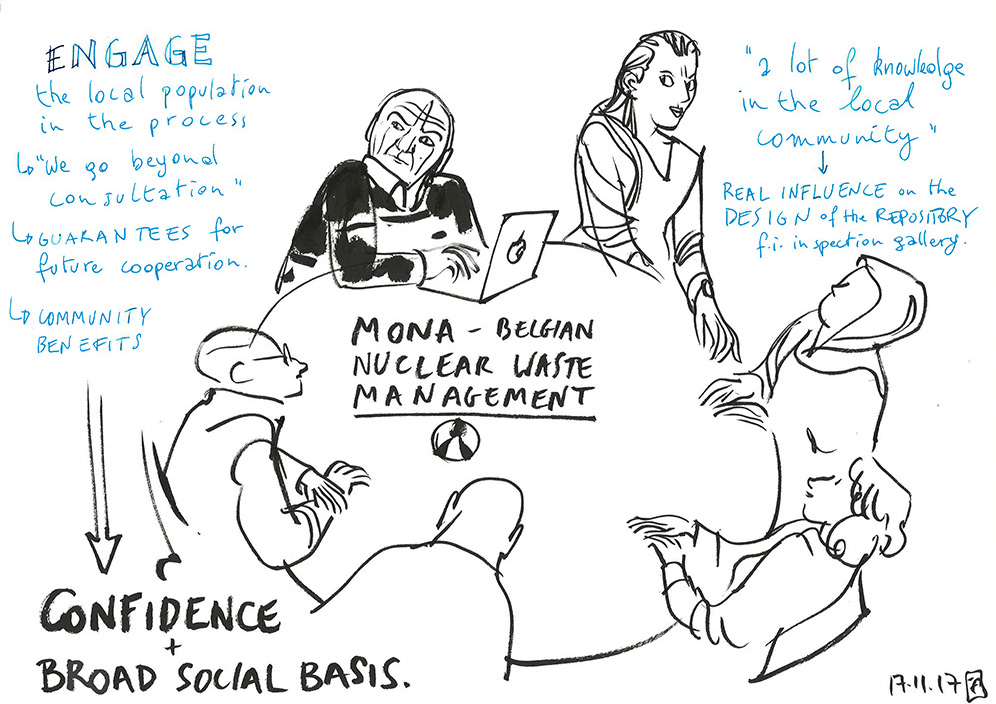
Artists Jon Thomson and Alison Craighead presented their temporary index for Dessel in the Perpetual Uncertainty exhibition. The work is a prototype public artwork for the Category A waste storage site at Dessel, and counts down three hundred years in seconds. They have designed a series of counters for radioactive waste sites around the world, which are currently showing in art museums. To put the project in context Jon and Alison gave an overview of their art practice from a planetary perspective exploring the relationship between imagination and data and the globe. They often work with data in the form of numerical and algorithmic language to articulate deep time frames in art galleries and museums, and in public spaces. Their sign-post ‘HERE’ gives the number of miles of the earth’s circumference, effectively pointing to itself, revealing the globe as a closed system. In contrast their wood block print of the Voyager 1 Space Probe message to unknown species, or aliens, refers to the limits of human knowledge. The wood block creates a very physical and localised form of reproduction of the message in contrast to the message sent beyond our solar system. Working with the earth’s rotation the artists created a portrait of Tim Berners-Lee, inventor of the internet, using two live cameras located at opposite sides of the world. The image updates every 60 seconds and so as the earth rotates and orbits the sun, night becomes day and day becomes night, inverting the image. If the work can’t operate it means the internet has ceased (or the earth has stopped rotating)!
Roundtables
In the afternoon three parallel roundtable discussions took place, each group included a range of ages and experience including artists, people working in the French and Belgium radioactive waste agencies, school students and university researchers. Each group had a chair and a rapporteur who gave feedback to the plenary session before a big group supper where everyone continued to discuss their work and ideas.
The roundtable on Citizen Science and Participation was chaired by Anne Bergmans, and focused on a discussion with architects Juan Fernando Ródenas García and Carlos Gonzalvo Salas, working on the CAIT project in Catalan, Spain. Their project aims to transform a decommissioned nuclear site into a medical research and health centre, taking advantage of the nuclear skills and resources at the site to maintain the economy in the area. The concept challenges the decommissioning narrative of nuclear sites ‘returning to nature’ and the group discussed how community participation could work in this context, creating transparency and changing culture. They discussed the need to learn from the increased debate about global warming, how a person’s ‘nuclear footprint’ might be calculated in a similar fashion to a ‘carbon footprint’, and the potential of people using an app to peer monitor background radiation on their community.
The roundtable on Deep Time Communication through Inter-generational Relay (below) was chaired by Jasmine De Bruycker, and included a discussion on intergenerational responsibility, and different ways in which knowledge can be communicated from one generation to the next. Importantly the day included a range of ages, from students born in the 1990s, to retired nuclear engineers born in the 1930s, helping to create a forum for knowledge and experience to pass from one century to the next. Several other questions were discussed as well. Do we have a language to discuss deep time issues? Is it adequate to use the term “waste” for leftover nuclear material (because “waste” doesn’t seem to grasp its intense potency and continuous shaping of human life, creating a false sense of away)? How does the discussion on nuclear waste relate to nuclear energy? Does public dialogue slow down the whole cycle of nuclear production, or does it rather stimulate the nuclear, making it more acceptable, legitimate, and familiar? Is public debate a social license to operate? The discussion also included artist David Griffiths whose artwork in the Perpetual Uncertainty exhibition was inspired by his field research in Mol during 2016.
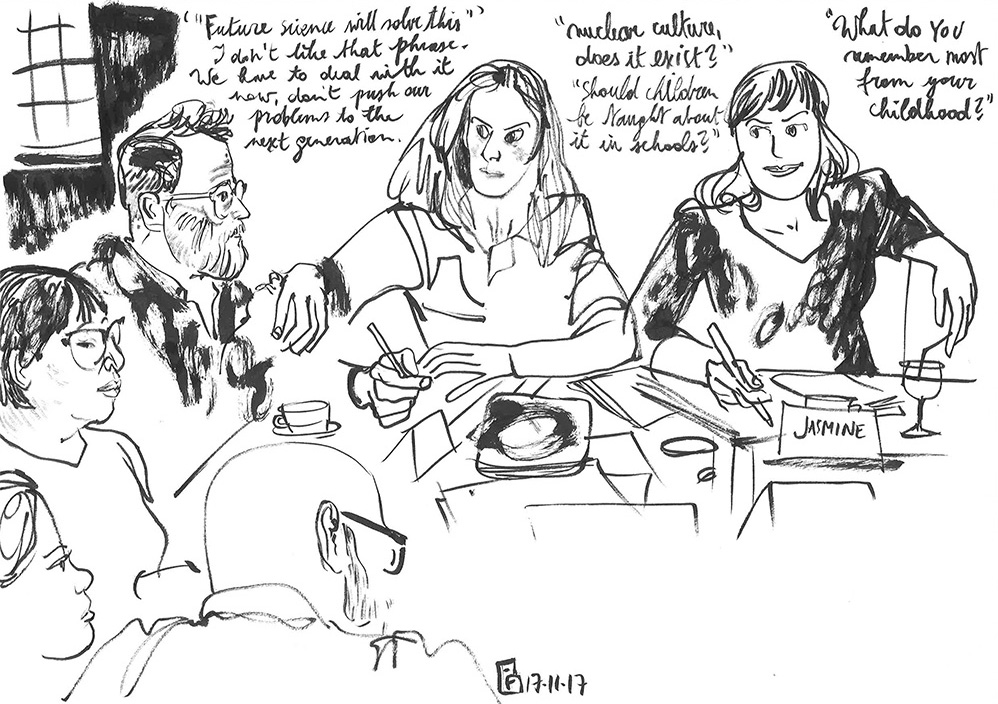
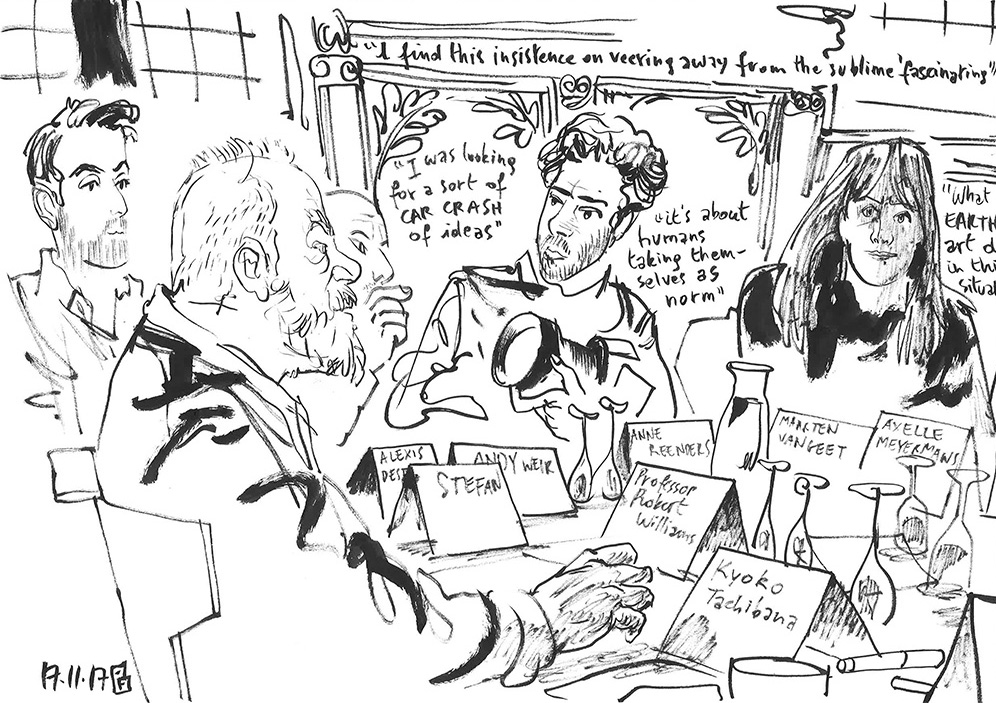
The roundtable on Deep Time Communication through Long Term Projection (above) was chaired by artist Robert Williams and explored the aesthetic and philosophical concerns of the morning presentations.
Rapporteurs from each group gave a synopsis of the discussions to the plenary session at the end of the day, highlighting the problems of oppositional politics, the need for a nuclear footprint analysis, and the complex discourse of nature, especially in relation to a post-human future (below).
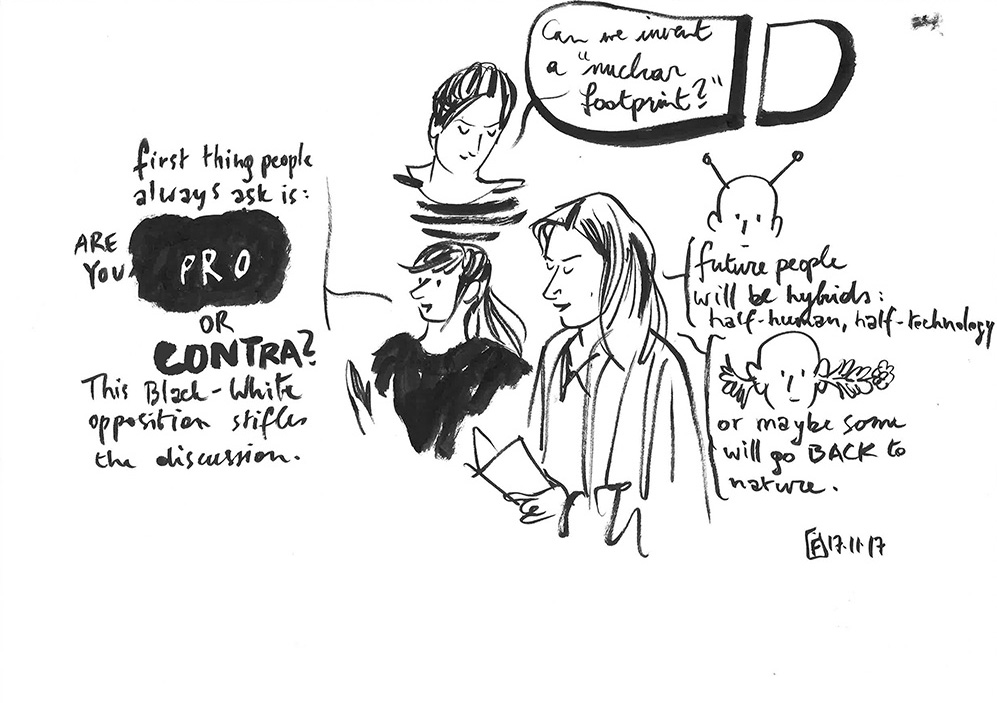

Régine reported that the group discussion started by addressing the impact of climate change on the environment and thus on the conditions and safety of storing radioactive waste. The group discussed different kinds of long-lived toxic waste stores that will be effected by rising sea levels. For example in low-lying Amsterdam there is a dump for chemical waste inside a concrete structure buried under a park. It is monitored daily and the structure is supposed to last till the end of time. In North Holland, the highest landscape is actually a waste site. The group discussed the importance of adopting a perspective similar to the one of the geologists who understand phenomena that extend far beyond the human scale and can think in millions and billions of years. Although the speed of climate change might supersede some of this deep time thinking.
The main strategies for nuclear waste management are sociological (passing on a baton, managing the waste through generations) or geological (message in a bottle, disposal). And there were two specific examples by artists in the group. French artists Alice and David Bertizzolo presented their ‘Cloud In / Cloud Out’ proposal that won the first prize in a competition for artists organized by ANDRA, the French Agency for Radioactive Waste (Agence Nationale pour la gestion des déchets radioactifs). The project uses repetition as a strategy, relying on the multiplication of the occurrence of the message to ensure that the information will be passed on over generations. The work involves a series of plastic hemispheres labelled with a danger symbol which would be placed above ground around a nuclear site, designed to become embedded in the landscape over hundreds of years.
On the other hand, a concept like The Atomic Priesthood explored by Robert Williams and Bryan McGovern Wilson in the Cumbrian Alchemy project in the Perpetual Uncertainty exhibition at Z33, relies on the power of folklore, mythology and traditions to communicate through deep time. Building on Thomas Sebeok’s concept of the Atomic Priesthood (1984), Cumbrian Alchemy also acknowledges the importance of oral tradition because spoken language seems to have greater longevity than written language. With this strategy, fear is used as a marker, as the priest would inspire fear around radioactive sites so that people would avoid them.
The group discussed the need to take into account the fact that information might get lost eventually. For example, there is little consensus around the meaning of the drawings of the Lascaux caves; and the Roman tumuli built to cover tombs were assumed to be part of the natural part of the landscape until someone started to dig. But in the case of nuclear waste buried under the landscape, how do you deal with human curiosity? How do you ensure that no one will want to open up dangerous storage facilities? Do people really need to know about the presence of the stores anyway? Isn’t it potentially dangerous to mark the site?
To predict the future, you also need to look backward to the 2-billion-year-old natural fission reactors in Oklo, Gabon, featured in Susan Schuppli’s film Trace Evidence (2016). One of the problems that plagues conversations around the nuclear is that it remains something mysterious to most: there is an urgent need to demystify the nuclear. One point of view is that we need to trust our planet and take into consideration the probability that humans might not be here for as long as these radioactive materials are dangerous. When thinking about the human occupation of the planet, we have already colonised the sky with planes, rockets, drones, radio waves, satellites, etc. Underground shouldn’t be an out-of-sight space although it is increasingly being filled up with data storage spaces, etc. The group discussed how, ultimately, humans need to take greater responsibility of the production of waste. Plastic is an interesting case: we have now learnt to recycle it but we keep on using it, instead of trying to replace it with less toxic materials. Perhaps there are lessons to be learned from other kinds of waste management?
The next Nuclear Roundtable will take place on Friday 4th May 2018 at the Malmo Konstmuseum, Sweden.